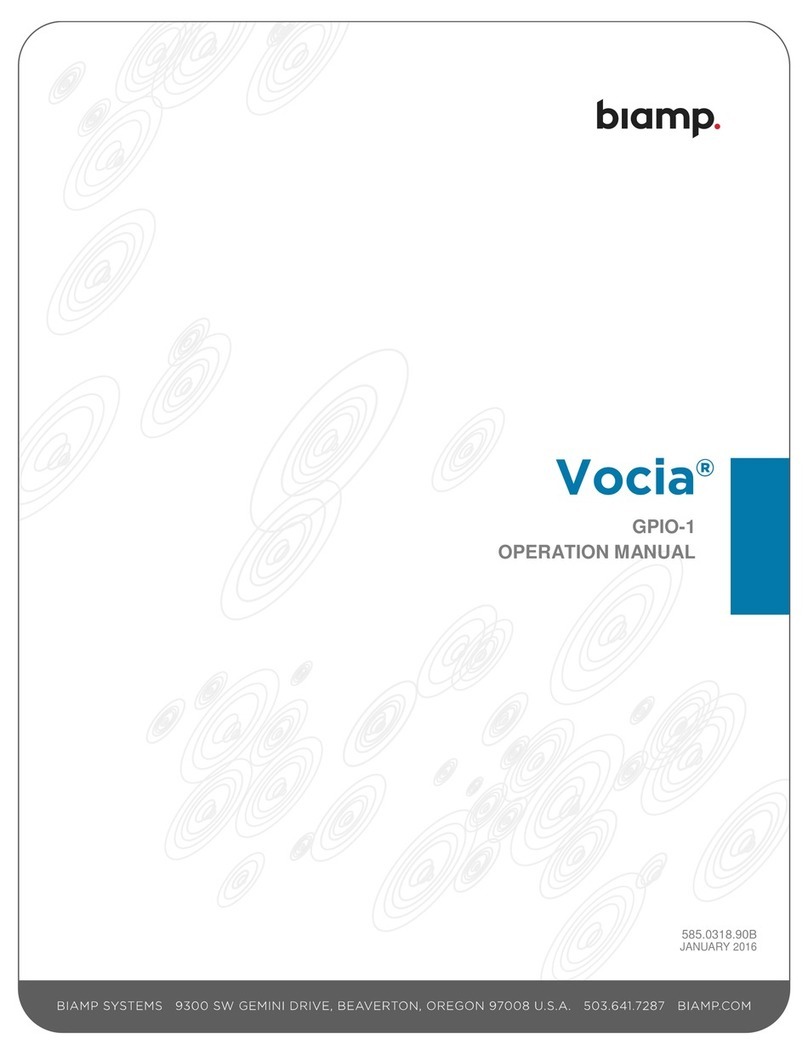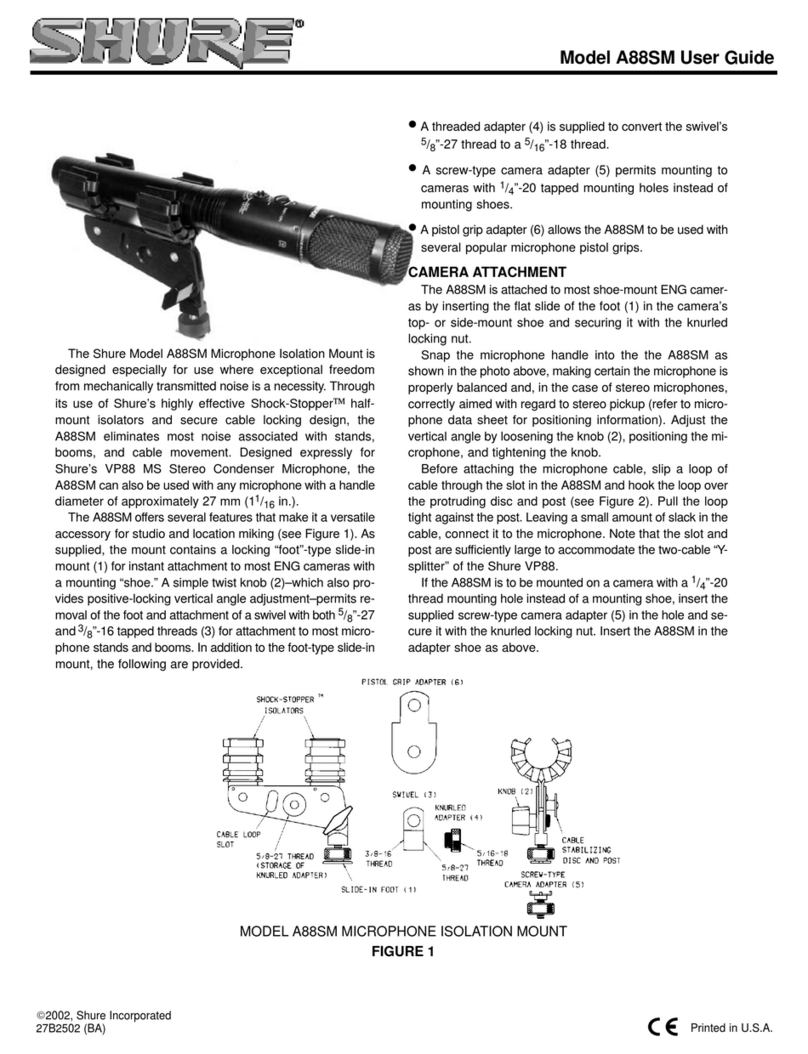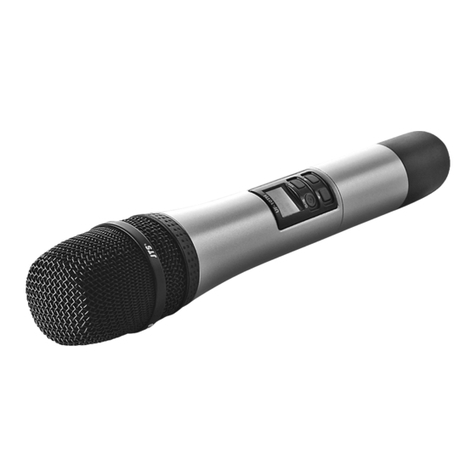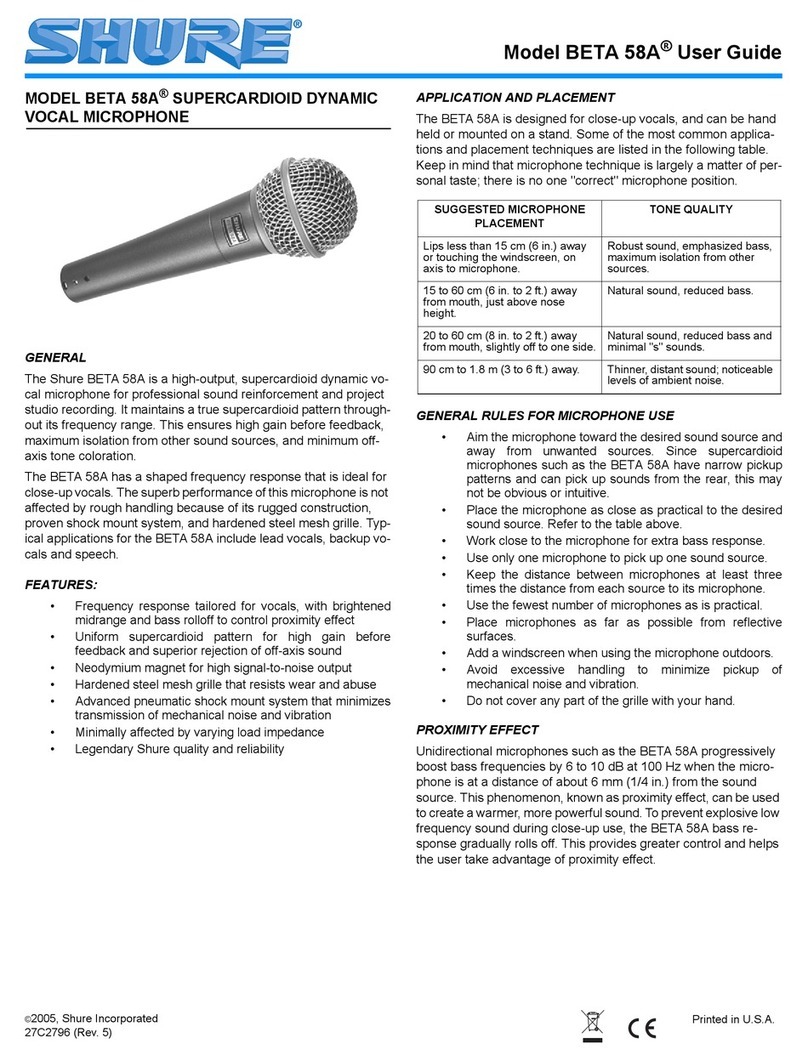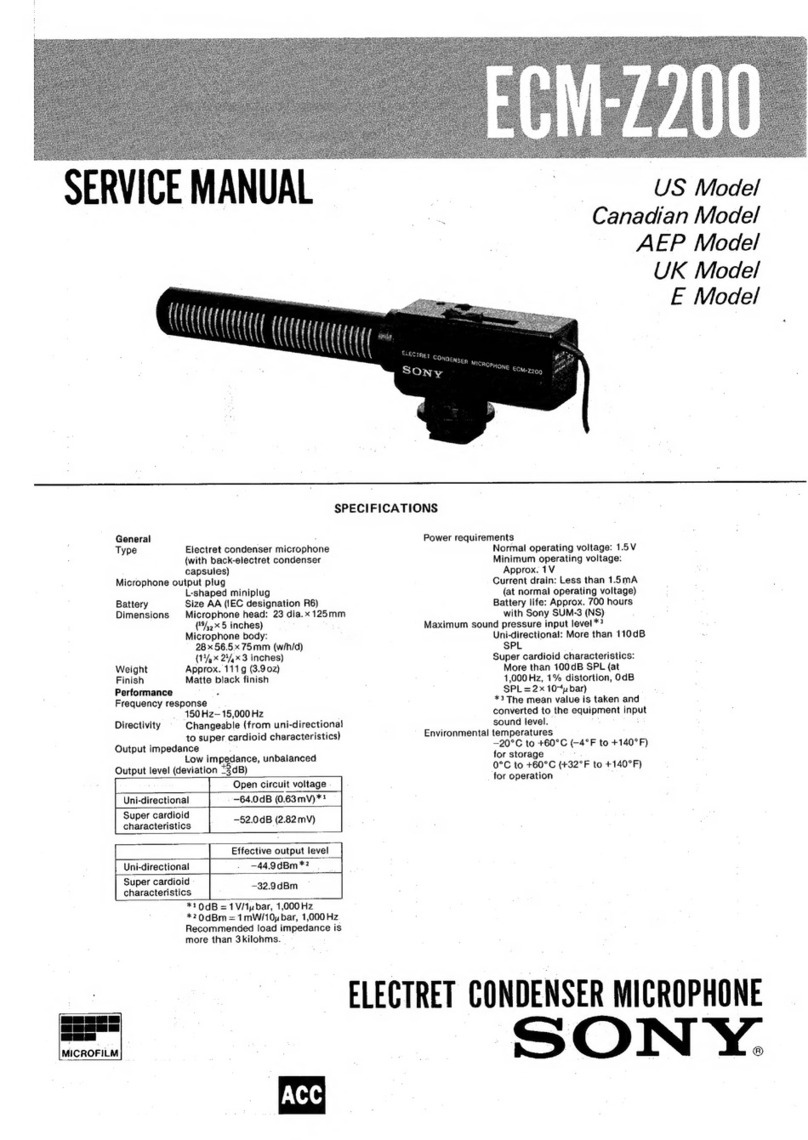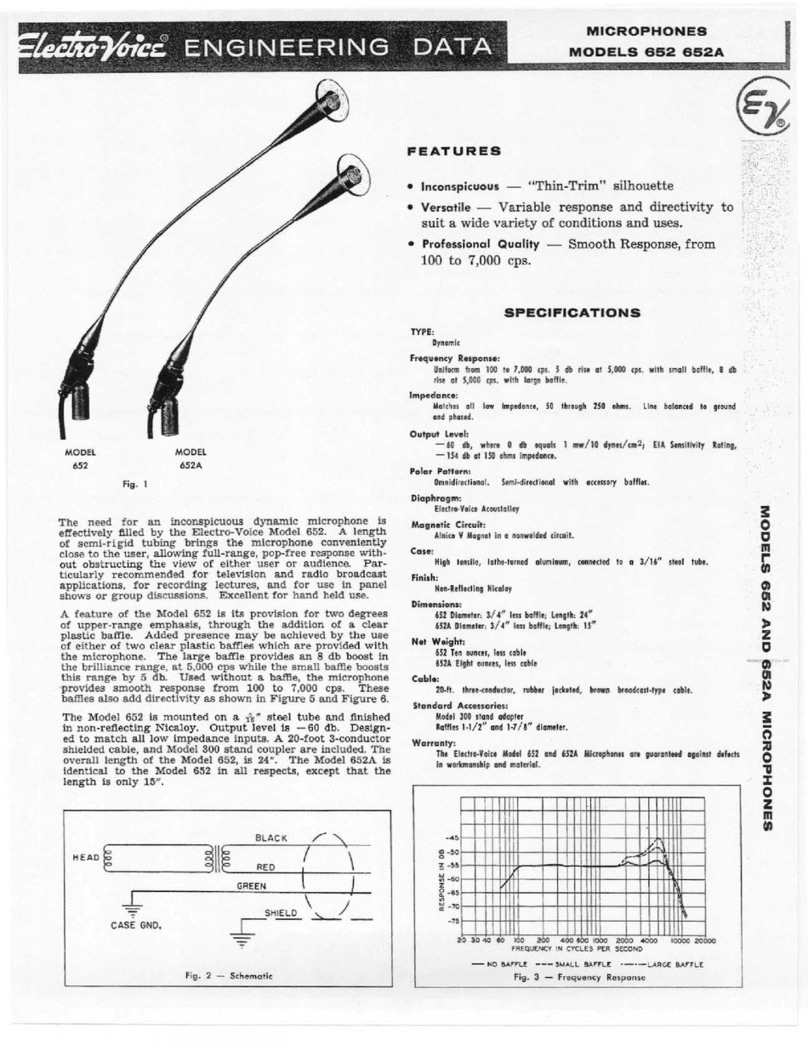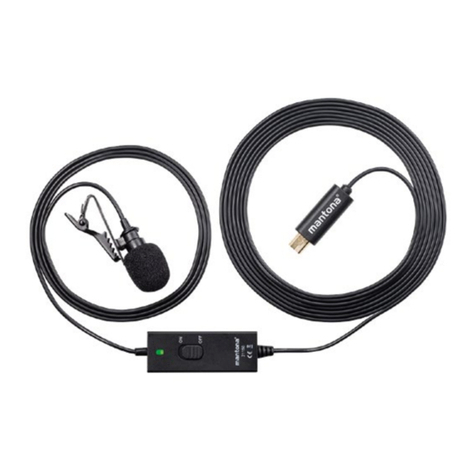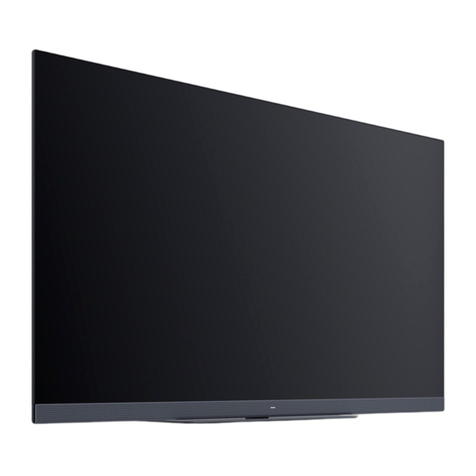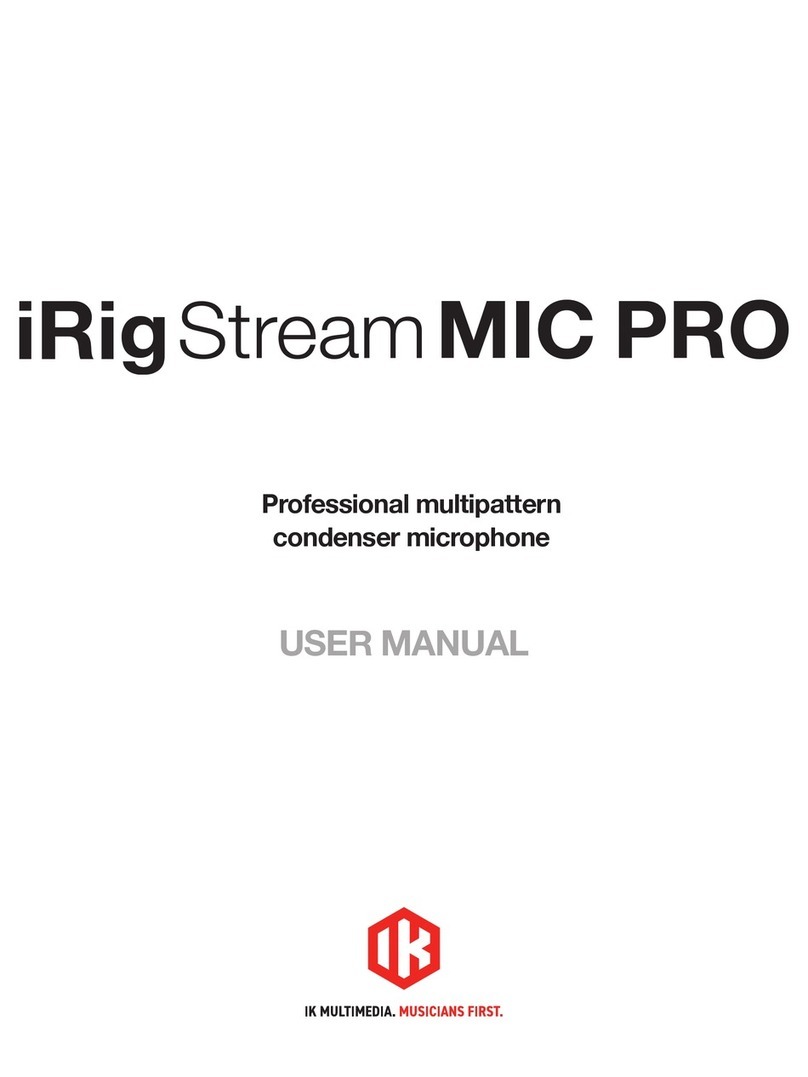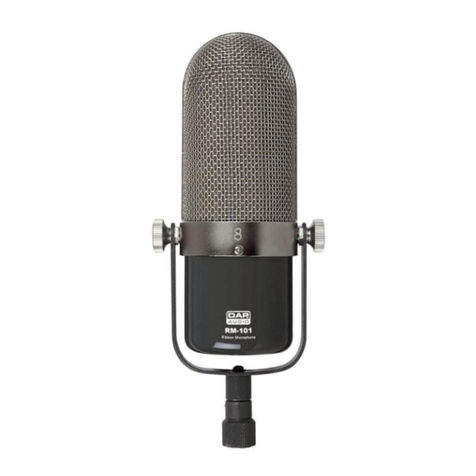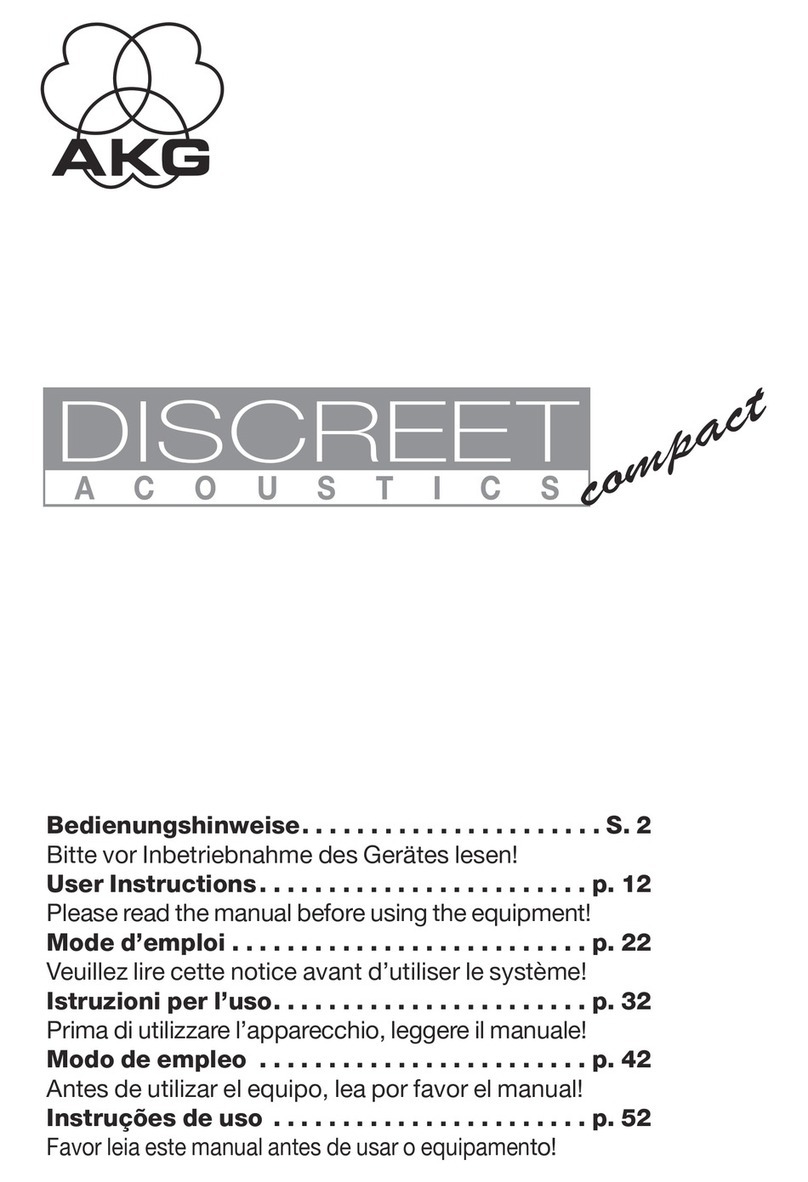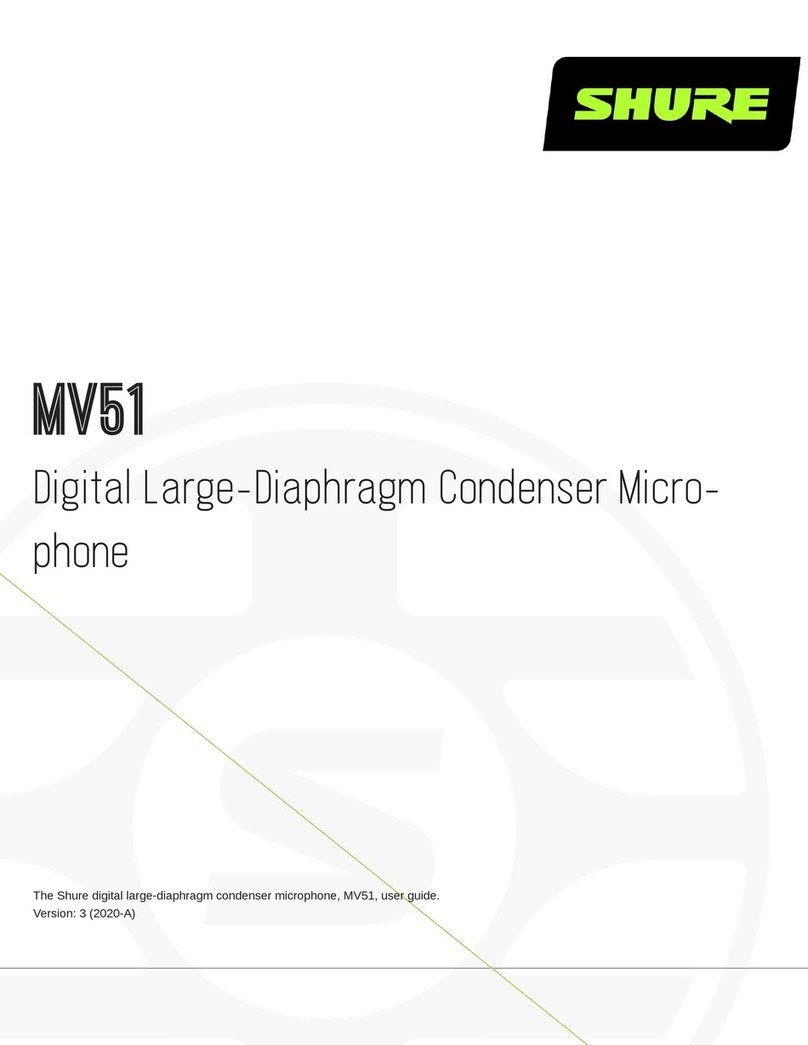Biamp Tesira TCM-1 User manual

TCM-1 Beamtracking™ Ceiling Microphone
TCM-1A Beamtracking™ Ceiling Microphone with Amplifier
TCM-1EX Beamtracking™ Expansion Ceiling Microphone
OPERATION MANUAL
APRIL 2018

TCM-1, TCM-1A & TCM-1EX PRODUCT DESCRIPTION
Tesira TCM-1
The TCM-1 is an AVB ceiling microphone for use in Tesira systems. Comprising a pendant microphone and plenum box,
each microphone includes Beamtracking™ technology with three 120-degree zones, providing full 360-degree coverage
of the meeting space. The TCM-1 microphone actively tracks and intelligently mixes conversations from around the table,
allowing far-end conference participants to experience the conversation naturally. The Tesira TCM-1 comes with its own
digital signal processing module for beamtracking, and each plenum box comes with an additional RJ-45 connector for
daisy-chain connections. A maximum of three microphones are permitted per daisy chain (one TCM-1 required, plus up to
two TCM-1EX).
Tesira TCM-1A
The TCM-1A is an AVB ceiling microphone and PoE+ amplifier for use in Tesira systems. Comprising a pendant
microphone and plenum box, each microphone includes Beamtracking™ technology with three 120-degree zones,
providing full 360-degree coverage of the meeting space. The TCM-1A microphone actively tracks and intelligently mixes
conversations from around the table, allowing far-end conference participants to experience the conversation naturally.
The 2-channel PoE+ amplifier includes an internal limiter, software configurable amplification, and a “burst” mode to
support higher power levels for dynamic content. The TCM-1A comes with its own digital signal processing module for
beamtracking, and each plenum box comes with an additional RJ-45 connector for daisy-chain connections. A maximum
of three microphones are permitted per daisy chain (one TCM-1A required, plus up to two TCM-1EX).
Tesira TCM-1EX
The TCM-1EX is an expansion ceiling microphone for use with the TCM-1 or TCM-1A in Tesira systems. Comprising a
pendant microphone and plenum box, each microphone includes Beamtracking™ technology with three 120-degree
zones, providing full 360-degree coverage of the meeting space. The TCM-1EX provides an expansion microphone for a
TCM-1 & TCM-1A which actively tracks and intelligently mixes conversations from around the table, allowing far-end
conference participants to experience the conversation naturally. The Tesira TCM-1EX is intended to be used as a
second or third microphone in conjunction with a TCM-1 or TCM-1A; it cannot operate as a standalone device. Each
plenum box comes with an additional RJ-45 connector for daisy-chain connections. A maximum of three microphones are
permitted per daisy chain (one TCM-1 or TCM-1A required, plus up to two TCM-1EX).

TCM-1, TCM-1A & TCM-1EX SETUP AND USE
Tesira TCM-1 Tesira TCM-1A
Tesira TCM-1EX
Tesira AVB Beamtracking pendant microphone
for use with TCM-1, TCM-1A and TCM-1EX
Setup and Use
The Tesira software provides an intuitive interface for setup and programming of the TCM-1, TCM-1A and the TCM-1EX.
The information supplied by this manual relates to physical connections and device setup. For more details on software
setup, please consult the Tesira Help File. For device specifications and microphone polar pattern please consult the
datasheet.
The Tesira TCM-1, TCM-1A and TCM-1EX do not connect with Telecom Network Voltage (TNV) circuitry and are
considered Network Environment Zero devices

TCM-1 & TCM-1A FRONT PANEL
Figure 1 TCM-1A
Figure 2 TCM-1
1. AVB/Control
Facilitates connection to the Tesira AVB network for audio transmission and control. This RJ-45 port may either
be connected directly to the Tesira AVB port (via a PoE+ injector) for a single device system, or via a PoE+
network switch in a multi-device AVB system. The TCM-1 is an IEEE 802.3 Type 1 Class 3 PoE device requiring
15.4W of PoE power. The TCM-1A is an IEEE 802.3 Type 2 Class 4 device requiring 30W of PoE+ power. There
are no other provisions for power inlet.
2. Mic (IN)
Allows up to two additional TCM-1EX expander microphone units in a daisy-chain topology. Use of this RJ-45 port
is optional and will depend on the number of additional microphones required to cover the acoustic space.
3. Power LED
A multi-color LED provides information about the status of the device.
Status
LED Indicator
No power
Off
Booting / Self-Test
Red Solid
Ready to receive configuration or updating firmware
Yellow Solid
Configured and ready to participate in the system
Green Solid
Unit is in Locate mode (triggered from the software)
Green Flashing
Unit has Major Alarm condition
Red Flashing
Unit has Minor Alarm condition
Yellow Flashing
Unit has both a Major and Minor Alarm condition
Red & Yellow Flashing

TCM-1 & TCM-1A FRONT PANEL
4. Amp LED (TCM-1A only)
A multi-color LED provides information about the status of the amplifier.
Status
LED Indicator
No power
Off
Powered
Green Solid
Amplifier limiter engaged
Yellow Solid
Amplifier is in Locate mode (triggered from the software)
Green Flashing
Amplifier has Major Alarm condition
Red Flashing
PoE+ power is not available or insufficient to power the
amplifier - it has been turned off
Red & Yellow Flashing
5. Output 1 & 2 (TCM-1A only)
2 x 4W RMS or 1 x 8W RMS output at low impedance 4Ω / 8Ω.

TCM-1EX FRONT PANEL
Figure 3 TCM-1EX
1. Mic (IN)
Allows for connection of a single additional TCM-1EX expander microphone unit in a daisy-chain topology, with a
maximum of 2 TCM-1EX units per TCM-1 or TCM-1A. Use of this RJ-45 port is optional and will depend on the
number of additional microphones required to cover the acoustic space.
2. Mic (OUT)
Facilitates connection to the host TCM-1 or TCM-1A unit or can be used to provide a link to the TCM-1EX when
used a multi-microphone daisy-chain topology.
3. Link LED
Illuminates when a valid link is detected from the host TCM-1 or TCM-1A.

TCM-1, TCM-1A & TCM-1EX MICROPHONE
Figure 4TCM-1, TCM-1A and TCM-1EX Microphone
1. LED Indicators
3x multi-color LED’s offset by 120 degrees provide information about the status of the microphone. Default LED
indication is shown in the table below. Some LED behavior may be changed during configuration of the software.
Status
LED Indicator
No power
Off
Configured and operating normally
Green Solid
Unit is in Locate mode (triggered from the software)
Green Flashing
Microphone is Muted
Red Solid
Unit has a Major Alarm condition
Red Flashing
2. Biamp Logo
Defines the front of the microphone when looking at the Azimuth Angle in the software.

TCM-1, TCM-1A & TCM-1EX WIRING TOPOLOGIES
Example Topologies
Figure 5 TCM-1A with 2x TCM-1EX
Figure 6 TCM-1 with 2x TCM-1EX
NOTE: The TCM-1 and TCM-1A cannot be daisy-chained together.

TCM-1, TCM-1A & TCM-1EX WIRING TOPOLOGIES
Example Topologies – Amplifier Speaker Wiring
Figure 7 Amplifier speaker wiring (TCM-1A only)
All speaker wiring connections require Class 2 wiring and should be made by qualified personnel with the amplifier power
removed.
Channel Assignment & Power Ratings
The amplifier can be configured in either single channel or two channel mode in the Tesira software. In 2 channel mode,
outputs 1 & 2 will be active and pass audio. In single channel mode, only channel 1 will be active and pass audio. Channel
2 will not pass audio even if a speaker is connected.

TCM-1, TCM-1A & TCM-1EX INTERNAL CONNECTIONS
Internal Connections
The TCM-1, TCM-1A and TCM-1EX include a folded metal enclosure (plenum) designed for permanent installation on a
ceiling or other horizontal surface, above a ceiling tile, or on a vertical surface. The devices are passively cooled and do
not have ventilation ports.
A 2-pin connector is located on the inside of the plenum to connect the pendant microphone. The connector is keyed to
prevent incorrect polarity. The microphone is designed to be suspended from the plenum by the cable. The length of the
suspended cable is adjustable by pinching the soft plastic on the under-side of the microphone mount. This allows the
cable to be extended or shortened to the desired length.
Figure 8 Pinch-points for Microphone Cable Length Adjustment
Strain relief for the microphone cable should be fitted using the included zip-ties by securing it to either the circuit board
(TCM-1EX) or the circuit board protective barrier (TCM-1 & TCM-1A) inside the plenum. Excess cable may be coiled as
shown in the figures below.
CAUTION: Make sure the cable is not strained or the zip-tie overtightened as damage may occur.
Figure 9 TCM-1 & TCM-1A Figure 10 TCM-1EX
Punch out through-holes in the plenum allow the microphone cable to exit either vertically or horizontally through the
microphone mount. Keyed mounting holes allow installation on a vertical or horizontal surface or above a ceiling tile. The
plenum design allows for an optional seismic cable to be connected.

TCM-1, TCM-1A & TCM-1EX INSTALLATION
Mounting & Installation
General Mounting and Installation Notes
•The maximum distance between an Ethernet switch and a TCM-1 or TCM-1A plenum box is 330 feet (100
meters).
•The maximum distance between daisy-chained TCM plenum boxes is 33 feet (10 meters).
•The maximum adjustable length of the microphone pendant cable is 4.9 feet (1.5 meters).
•The TCM-1, TCM-1A and the TCM-1EX may be mounted above the ceiling tile or attached to the ceiling
or a vertical surface. The devices comply with UL-2043 Plenum rating.
Installation Option – Above Ceiling Tile Mounting
NOTE: the plenum cover must be removed for this installation option. No tools are required.
NOTE: this procedure assumes the ceiling tile has already been modified to accommodate the microphone and
mount provided.
1. Install the microphone mount through the hole in the tile and the plenum.
2. Secure the microphone mount with the retaining hardware (nut) from inside the plenum.
3. Set the microphone height by using the pinch points on the mount to extend or retract the cable as
required.
4. Attach the microphone connector to the socket on the inside of the plenum.
5. Attach the microphone cable to either the circuit board (TCM-1EX) or the circuit board protective barrier
(TCM-1 & TCM-1A) with the provided zip-ties.
6. Coil any excess cable inside the unit and secure with a zip-tie as shown in Internal Connections.
CAUTION: Ensure the cable is not strained or the zip-tie overtightened as damage may occur.
7. Install the plenum cover.
Figure 11 Above Ceiling Tile Installation Option

TCM-1, TCM-1A & TCM-1EX INSTALLATION
Installation Option – Ceiling Mounting
NOTE: the plenum cover must be removed for this installation option. No tools are required.
1. Attach the plenum cover to the ceiling with hardware through the keyed mounting holes.
2. Install the microphone mount through the hole in the plenum.
3. Secure the microphone mount with the retaining hardware (nut) from inside the plenum.
4. Set the microphone height by using the pinch points on the mount to extend or retract the cable as
required.
5. Attach the microphone connector to the socket on the inside of the plenum.
6. Attach the microphone cable to either the circuit board (TCM-1EX) or the circuit board protective
barrier (TCM-1 & TCM-1A) with the provided zip-ties.
7. Coil any excess cable inside the unit and secure with a zip-tie as shown in Internal Connections.
CAUTION: Ensure the cable is not strained or the zip-tie overtightened as damage may occur.
8. Install the plenum on to the ceiling-mounted cover.
Figure 12 Ceiling Installation Option

TCM-1, TCM-1A & TCM-1EX INSTALLATION
Installation Option – Vertical Mounting
NOTE: the plenum cover must be removed for this installation option. No tools are required.
1. Attach the plenum to the vertical surface with hardware through the keyed mounting holes.
2. Install the microphone mount through the hole in the plenum.
3. Secure the microphone mount with the retaining hardware (nut) from inside the plenum.
4. Set the microphone height by using the pinch points on the mount to extend or retract the cable as
required.
5. Attach the microphone connector to the socket on the inside of the plenum.
6. Attach the microphone cable to either the circuit board (TCM-1EX) or the circuit board protective
barrier (TCM-1 & TCM-1A) with the provided zip-ties.
7. Coil any excess cable inside the unit and secure with a zip-tie as shown in Internal Connections.
CAUTION: Ensure the cable is not strained or the zip-tie overtightened as damage may occur.
8. Install the cover on to the vertical-mounted plenum.
Figure 13 Vertical Surface Installation

TCM-1, TCM-1A & TCM-1EX INSTALLATION
Seismic Cable (optional)
An optional seismic cable is available for the TCM-1, TCM-1A and the TCM-1EX.
1. To install the seismic cable, locate the holes in the plenum as identified by the arrows. Holes to accommodate the
cable are in similar locations for all TCM models.
Figure 14 Seismic Cable Installation
2. Feed the cable through the hole in the plenum so the end-stop remains inside.
Figure 15 End-stop Installation

3. Feed the cable through one end of the locking mechanism.
NOTE: the ends indicated by the blue arrow need to be depressed to allow the cable to pass through. Internal
guides make sure the cable will be routed through the correct path.
4. Attach the loop to a secure location and apply sufficient tension for minimal slack.
5. Make sure the ends of the lock mechanism are in the locked position (out) as indicated by the blue arrows.
Figure 16 Lock Mechanism Orientation
Visit www.biamp.com to obtain firmware and software updates related to this product. To speak with an Applications Engineer, please call

FCC Notice
FCC Part 15 –
This device complies with part 15 of the FCC Rules. Operation is subject to the following two conditions (1) this device
may not cause harmful interference and (2) this device must accept any interference received, including interference that
may cause undesired operation.
The following applies to products with a telephone interface:
This equipment complies with Part 68 of the FCC rules and the requirements adopted by the ACTA. On the rear of this
equipment is information that contains a product identifier in the format US:6RMEQ##TXXXX. If requested, this number
must be provided to the telephone company.
This equipment is designed for modular connection with Jack Universal Service Order Codes RJ-14C, RJ-14W.
A plug and jack used to connect this equipment to the premises wiring and telephone network must comply with the
applicable FCC Part 68 rules and requirements adopted by the ACTA. CAUTION: To reduce the risk of fire, use only No.
26 AWG or larger (e.g., 24 AWG) UL Listed or CSA Certified Telecommunication Line Cord.
The Ringer Equivalence Number (REN) is used to determine the number of devices that may be connected to a telephone
line. Excessive RENs on a telephone line may result in the devices not ringing in response to an incoming call. In most
but not all areas, the sum of RENs should not exceed five (5.0). To be certain of the number of devices that may be
connected to a line, as determined by the total RENs, contact the local telephone company. For products approved after
July 23, 2001, the REN for this product is part of the product identifier that has the format US:6RMEQ##TXXXX. The
digits represented by ## are the REN without a decimal point (e.g., 03 is a REN of 0.3). For earlier products, the REN is
separately shown on the label.
If this equipment causes harm to the telephone network, the telephone company will notify you in advance that temporary
discontinuance of service may be required. But if advance notice isn't practical, the telephone company will notify the
customer as soon as possible. Also, you will be advised of your right to file a complaint with the FCC if you believe it is
necessary.
The telephone company may make changes in its facilities, equipment, operations or procedures that could affect the
operation of the equipment. If this happens the telephone company will provide advance notice in order for you to make
necessary modifications to maintain uninterrupted service.
This equipment is not user serviceable. If trouble is experienced with this equipment, for repair or warranty information,
please contact Biamp Systems Corporation, phone number 503.641.7287. If the equipment is causing harm to the
telephone network, the telephone company may request that you disconnect the equipment until the problem is resolved.
Connection to party line service is subject to state tariffs. Contact the state public utility commission, public service
commission or corporation commission for information.
If your facility has specially wired alarm equipment connected to the telephone line, ensure the installation of this
equipment does not disable your alarm equipment. If you have questions about what will disable alarm equipment,
consult your telephone company or a qualified installer.
Other manuals for Tesira TCM-1
1
This manual suits for next models
2
Table of contents
Other Biamp Microphone manuals

Biamp
Biamp Vocia PSKIT-1 User manual
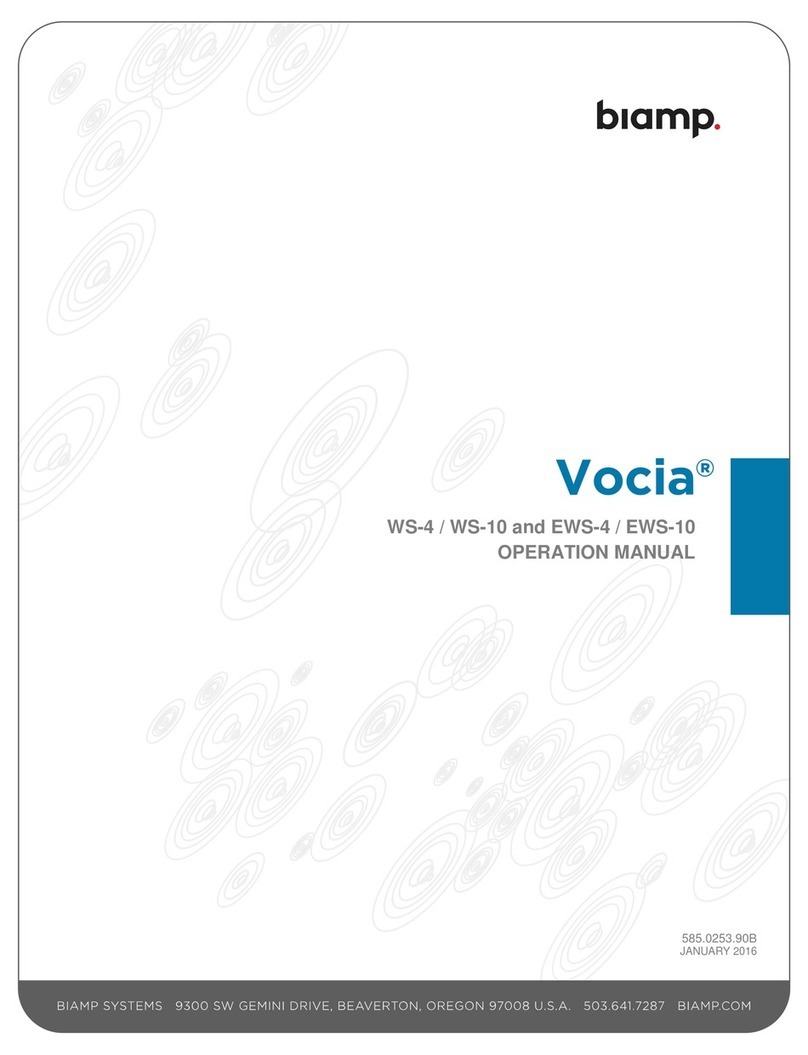
Biamp
Biamp Vocia WS-4 User manual

Biamp
Biamp Vocia WS-10 User manual
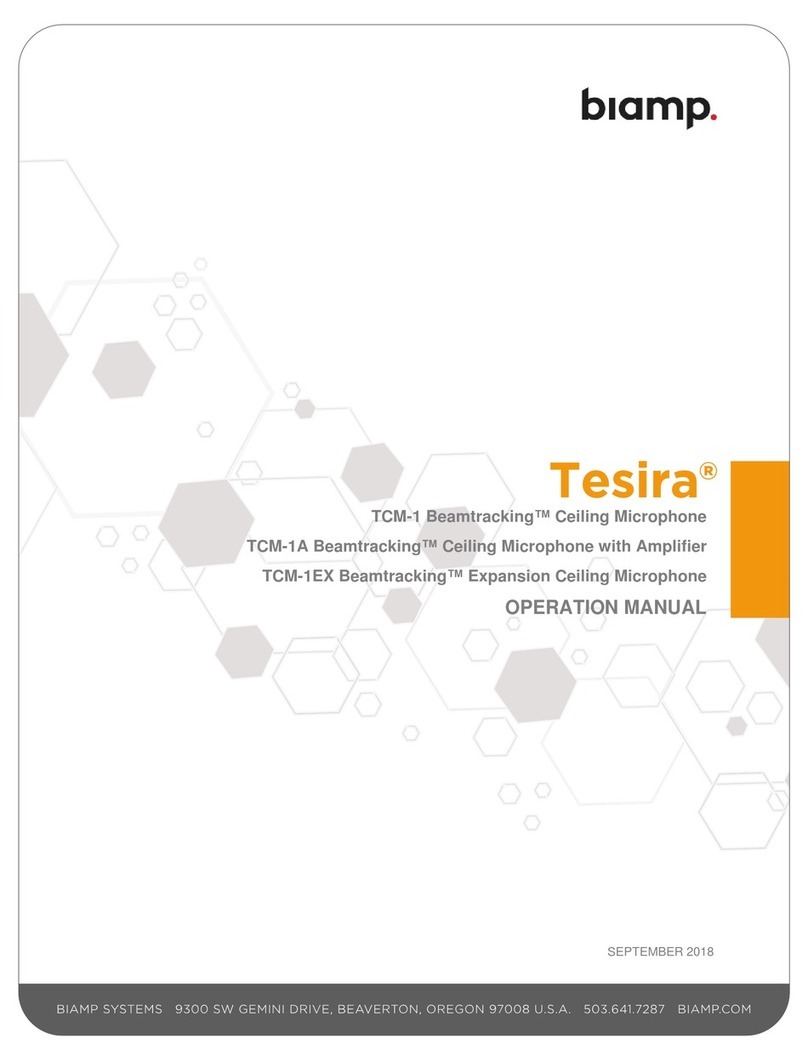
Biamp
Biamp Tesira TCM-1 User manual
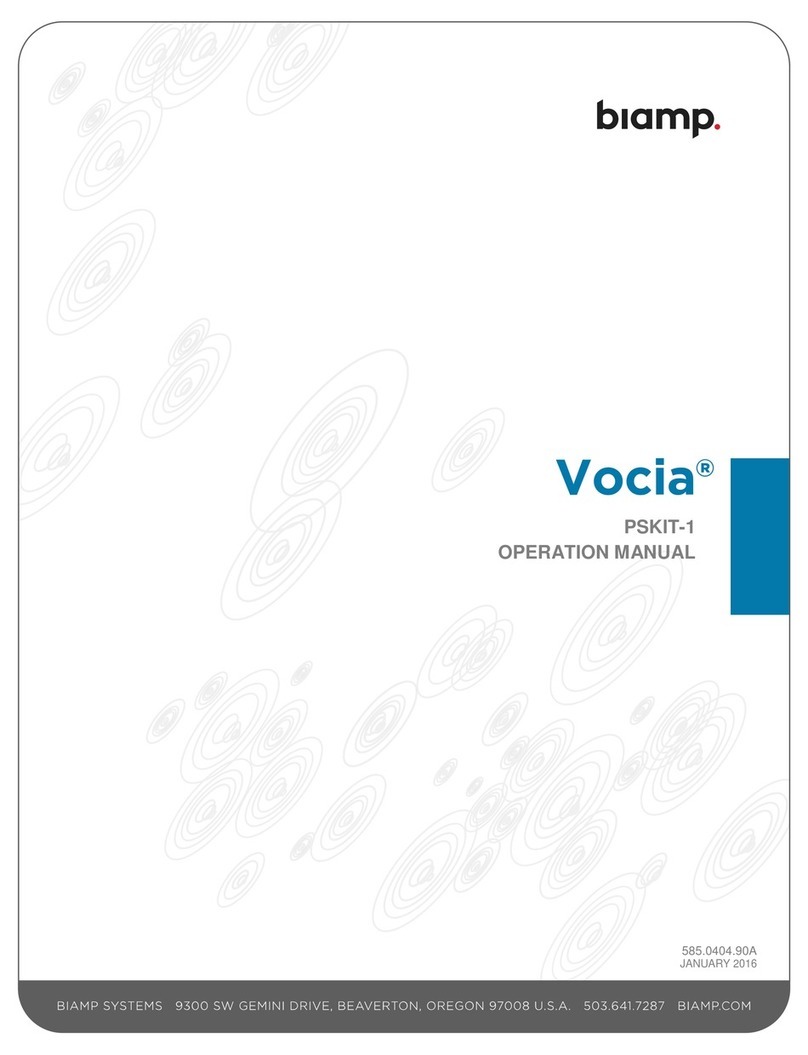
Biamp
Biamp Vocia PSKIT-1 User manual
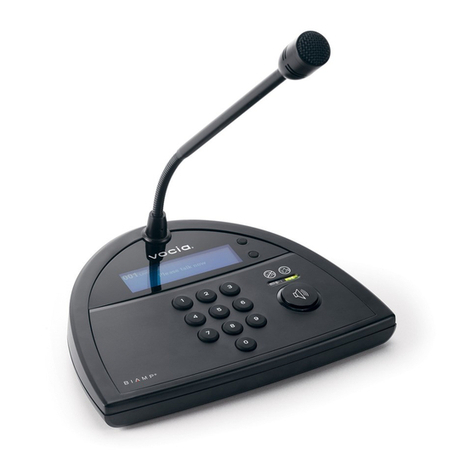
Biamp
Biamp Vocia DS-4 User manual
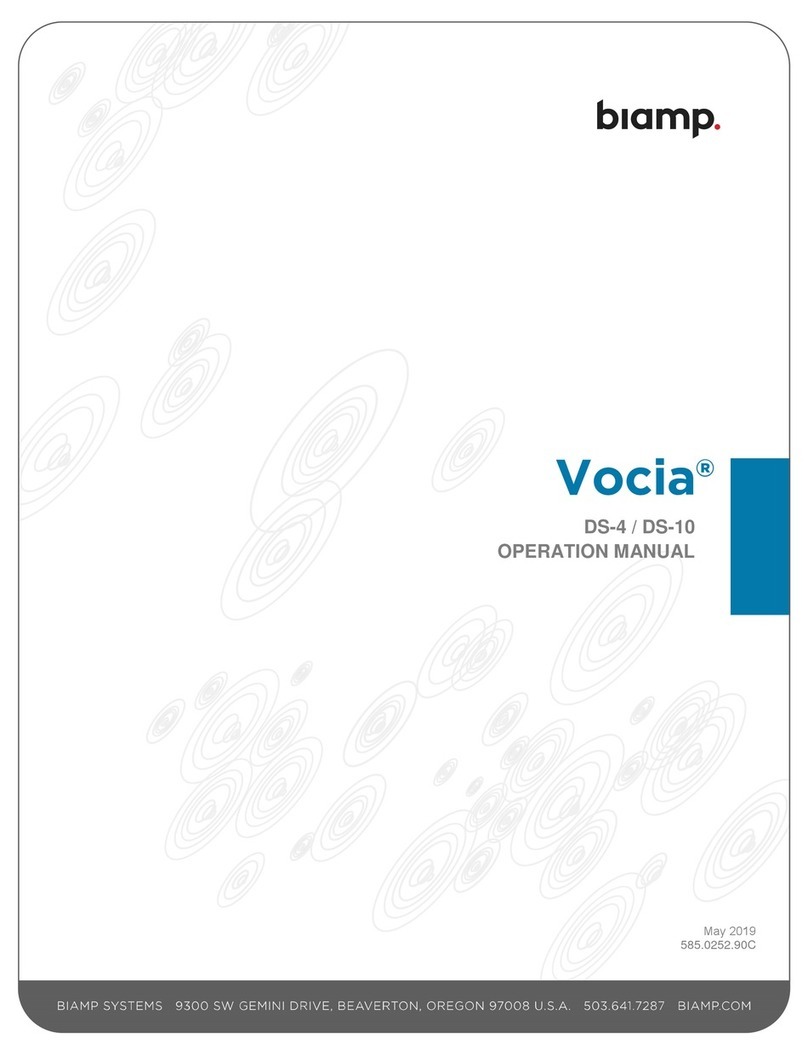
Biamp
Biamp Vocia DS-4 User manual

Biamp
Biamp NPX H1040 Original operating instructions

Biamp
Biamp DCM-1 User manual

Biamp
Biamp Parlé TTM-X Original operating instructions


